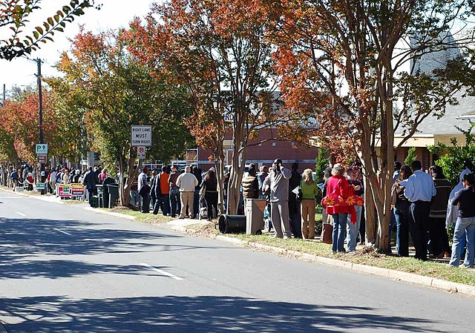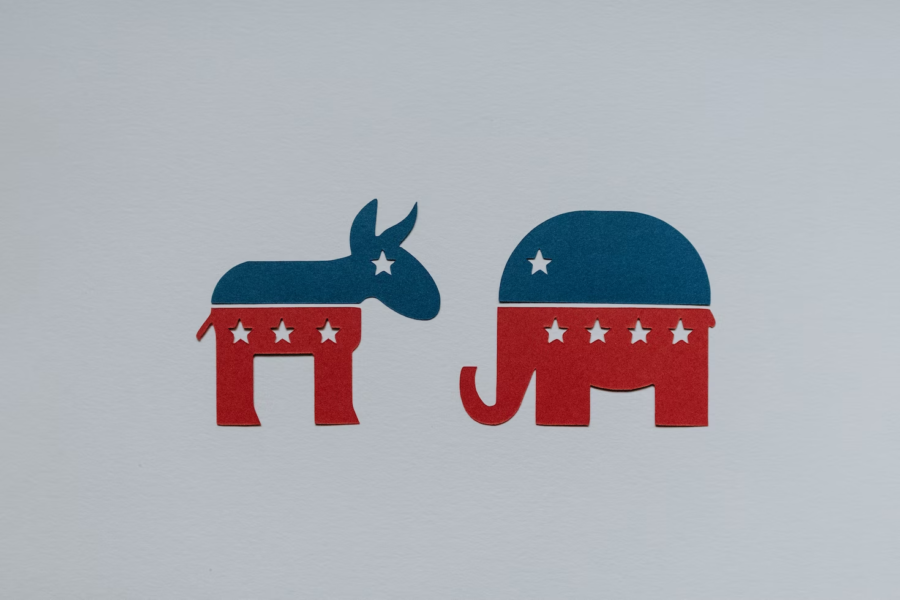Voting in Polarized America
Political polarization has disturbed the United States since the country’s founding. However, its impact on young generations of voters has been long overlooked – why?
The current tensions between American political parties have caused extreme divisions in politics that have resulted in our current problem of extreme political polarization.
The United States’ youngest are the ones who do not show up where it matters — in the polls. This is demonstrated by the 2020 voter turnout where 76.0% of voters 65 – 74 years of age cast a ballot, whereas only 51.4% of voters 18 – 24 years of age did the same. The reluctant demographic, referred to as Generation Z (Gen Z), do not see value in their voices because of the extreme polarization of American politics.
Political polarization is the divergence of political attitudes from the middle ground to an extreme ideology that is affiliated with a particular party. Many times, polarization can be categorized by the level of hatred between people of opposing parties. Gen Z, the upcoming generation of voters, is less inclined to vote in recent elections because they find them to be highly polarized between the Democratic and Republican parties.
This generation is the most technologically capable, and as a result, around 50% of Gen Z uses social media as a way to consume news daily. However, social media news consumption is not limited to Gen-Z, as the rest of the country follows suit with about 35% of U.S. adults over the age of 24 (Millennials, Generation X, and Baby Boomers) getting news from social media daily. Politics are affected by social media when online platforms gain popularity and stature of their own. According to a Vanderbilt University study, voters can now choose to either opt-out of politics altogether because they no longer have to watch the nightly news network to find out what’s happening, or they can choose to immerse themselves in the constant presence of social media that ensures they are routinely updated. Social platforms are accused of allowing certain thoughts or reactions posted online to spin into something larger than what is reality. “Perhaps social media makes us think that we’re more disunified than we really are,” said Mary Catherine Sullivan, the project’s lead researcher.
All of this partisanship manifests itself as a psychological barrier to young voters making their way to the polls. “Young voters have watched political turmoil and polarization unfold, so the intent is to decrease it,” said Kyla Rosin ’23. Seeing both parties argue their respective extremes rather than fight for their constituents numbs the younger generation from the political scene. With ideologies that are still developing, young voters do not see themselves represented.
The impact that partisanship has had on young voters has been long overlooked, as well. The young voter demographic has historically been the group least likely to show up at the polls. In 2018, about 31% of young people (ages 18-29) cast a ballot in the midterm elections, “a high-water mark” for youth voter turnout during midterms in the U.S. since at least the 1970s, as youth voter turnout has hovered around 20% during midterm elections. However, this is 31% of youth voters as compared to 54% of the general voting population that cast a ballot. A study finds that the United States’ young voter turnout is the fifth lowest in the world. Daniel Selz, Director of Innovation for the Leadership Now Project, explained, “Younger people tend to wonder: ‘how could these elections even matter to me?’ They don’t believe in the structure of our political systems because the two-party system has an ‘us versus them’ mentality and doesn’t seem to benefit younger people.” The older generations of voters, on the other hand, react differently to polarization in politics because they harbor frustrations with the political system and have been let down by it. However, unlike young people, older generations are well represented in the government.

There is a large age divide as the average age for members of congress is between 54 and 65 years old. “The candidates seem much older, so there is a large disconnect for younger people,” said Selz. The current political climate is less focused on serious issues and more intent on working against one’s opponent is a major reason behind this disconnect. The state of the United States today, after all, can be understood by examining the people who are meant to represent it, our elected officials. They are meant to be the backbone of our country; they supposedly magnify the voice of the American people. How can a democracy be sustained without the voices of voters?
When current Democratic Speaker of the House of Representatives, Nancy Pelosi, describes her relationship with the Republican minority leader, Representative Kevin McCarthy, the mounting tensions in the foundation of the United States are clear.
Ms. Pelosi and Mr. McCarthy are both highly influential figures whose bitter rivalry parallels the relationship between the members of their respective parties. Ms. Pelosi’s spokesman, Drew Hammill, stated that Mr. McCarthy’s news conferences are “about par for the course for an uninspiring and incoherent politician like the minority leader, whose only real accomplishment to date is typing up a radical right-wing wish list that sends a clear message to the American people that House Republicans have gone off the deep end.” Ms. Pelosi has nothing kind to say about the minority leader and frequently expresses this sentiment. However, the insults are not one-sided either. Mr. McCarthy held a conference on July 29th, 2021 on the steps of the Capitol Building to discuss “firing Nancy Pelosi.” He has further said that the Speaker has “broken this institution,” labeling her a “lame duck speaker.” Both leaders of the House of Representatives are extremely negative about their counterparts which is reflected in the view of the broader American population.
Ms. Pelosi’s home was broken into on October 31st, 2022 by an assailant who wanted to “take hostage and perhaps break [her] kneecaps.” He saw her as “the ‘leader of the pack’ of lies told by the Democratic Party.” He allegedly wanted to “teach a lesson” to the Democratic members of Congress. Although Ms. Pelosi was not at her home at the time, the assailant attacked her husband, fracturing his skull with a hammer, a critical injury that required brain surgery. This extreme act of violence demonstrates the chaos that party divides manifest.
“People are turned off by how toxic politics are right now – it’s gross, old people shouting at each other – it doesn’t matter,” said Mr. Selz. With both party leaders in direct opposition to each other, the extreme polarization within the broader country is exacerbated.
The fractured pieces of the United States echo the government’s progress on important matters. When President Biden signed an infrastructure bill in November of 2021, many House Republicans voted against it. Infrastructure is a universal topic and can benefit constituents of both parties, therefore the strong “nay” vote was not easily understood. “A growing number of [those] who voted against the bipartisan infrastructure package last year are now striking a different tone by promoting components of the massive funding measure that they see as beneficial to their constituents,” NBC reporter Allan Smith said in January of 2022. The reasoning for this is that GOP lawmakers “want to deliver for their constituents, but they are also under pressure from House Republican leaders, former President Donald Trump and right-wing media to oppose Biden at every opportunity,” Smith added, so the lawmakers choose to maintain their position over carrying out their duty. A universally beneficial bill was opposed due to a dislike of the party that introduced it. “Now, voting is not for being excited about your candidate, or to help the people. It is because you don’t want the other guys to win,” Mr. Selz explained. Partisanship in the United States is exceedingly clear when elected officials vote against beneficial measures simply to stunt their opposing party.
Political polarization today is a direct result of American history. The original two-party system in the United States included the Federalists and the Democratic-Republicans. When President George Washington left office in 1796, he cautioned Americans on many matters in what became his famous Farewell Address. “The common and continual mischiefs of the spirit of party are sufficient to make it the interest and duty of a wise people to discourage and restrain it…It agitates the community with ill-founded jealousies and false alarms, kindles the animosity of one part against another, foments occasionally riot and insurrection.” Washington saw the inevitable hatred between factions that is fueled by polarization. In 1800, there was a split across the country between Federalist President John Adams and President Thomas Jefferson, a Democratic-Republican who beat Adams, ending his presidency after one term. The tensions were so severe that Adams was the only president other than Donald Trump who chose to not attend his successor’s inauguration. Even in the 1800s, opposing parties worked against each other.
The fundamental values of America depend on the system of democracy. The system is maintained through a strong voter force that accurately reflects the entire population. When looking at the polls, the represented population falls short of what America requires.
“People are turned off by how toxic politics are right now – it’s gross, old people shouting at each other – it doesn’t matter,” said Daniel Selz, Director of Innovation for the Leadership Now Project. “With both party leaders in direct opposition to each other, the extreme polarization within the broader country is exacerbated.”
Ayana Chari is a Copy Chief for 'The Science Survey.' She has always appreciated that works of journalism bring together fact and storytelling, informing...











